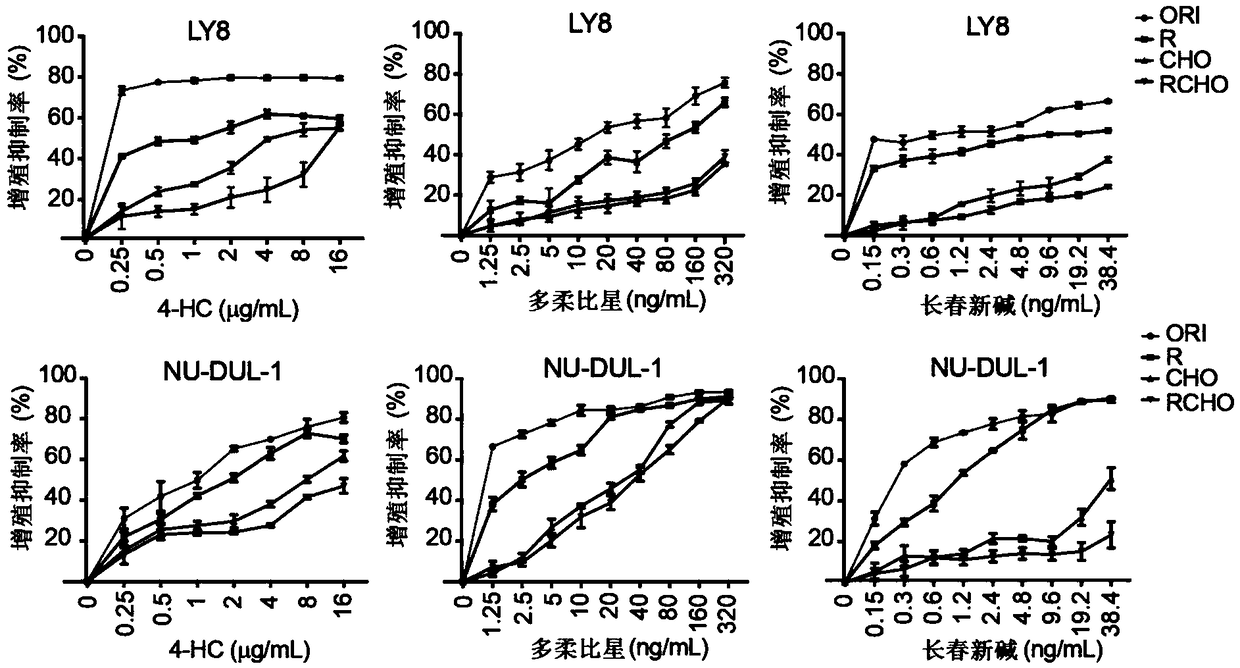Drug composition for treating B cell lymphoma
A composition and B cell technology, which can be used in drug combinations, anti-tumor drugs, active ingredients of heterocyclic compounds, etc., and can solve problems such as low success rate, death, and patient recurrence.
- Summary
- Abstract
- Description
- Claims
- Application Information
AI Technical Summary
Problems solved by technology
Method used
Image
Examples
Embodiment 1
[0127] Example 1 SOX2 regulates the drug resistance of stem cell-like drug-resistant DLBCL cells
[0128] Antibody-dependent cellular cytotoxicity (ADCC) and complement-dependent cytotoxicity (CDC) are the main mechanisms for the therapeutic effect of rituximab. Resistance to ADCC may arise from intrinsic characteristics of the individual patient's immune cells; whereas resistance to CDC results from low expression levels of CD20 and / or high expression levels of membrane-bound complement regulatory proteins (mCRP) (including CD46, CD55 and especially CD59) mediated. CHO chemotherapeutics inhibit tumor cell replication by inducing DNA damage or binding to tubulin, and cyclophosphamide must be metabolically activated in cells to 4-hydroxycyclophosphamide (4-HC) to exert this effect. Therefore, using rituximab plus normal human serum (NHS, as a source of complement), 4-HC plus doxorubicin plus vincristine, and their combinations, we constructed drug-resistant LY8 (GCB subtype) o...
Embodiment 2
[0130] Example 2 PI3K / AKT signaling phosphorylates and thereby stabilizes SOX2 against ubiquitination-mediated degradation
[0131] We next investigated the mechanism of SOX2 upregulation in drug-resistant DLBCL cells. Unexpectedly, SOX2 mRNA levels were significantly decreased in drug-resistant cells, especially in drug-resistant LY8 cells ( Figure 15 ), suggesting that transcriptional regulation is not involved in the overexpression of SOX2. Interaction scores from KEGG pathway analysis based on RNA-seq data from naive and drug-resistant cells showed that PI3K / AKT signaling pathway and steroid biosynthesis were the most enriched pathways ( Figure 15 ). Furthermore, gene set enrichment analysis (GSEA) revealed that gene signatures of the PI3K / AKT signaling pathway were significantly activated in both RCHO-resistant cell lines ( Figure 16 ). It was confirmed experimentally that the phosphorylation of AKT(S473) increases with the degree of drug resistance, thereby enhanc...
Embodiment 3
[0132] Example 3 Multiple signaling events activate PI3K / AKT pathway in drug-resistant cells
[0133] The study of the key regulators upstream of the PI3K / AKT pathway helps to find potential drug targets that can reduce the expression of SOX2. Therefore, we identified 124 upregulated genes in the PK3K / AKT pathway ( Figure 16 ) and classify them according to cell subtype ( Figure 22 ). Due to the limited number of overlapping genes (only 18) in the two cell subtypes, we used all 124 genes for KEGG pathway analysis. Figure 23 The top 10 pathways are listed, and the PI3K / AKT pathway is ranked first. PI3Kα / β isoforms are widely expressed, while PI3Kγ / δ isoforms are only expressed in hematopoietic cells, in which PI3Kδ plays a key role in the development and function of B cells, and in B cell malignancies through the expression of BCR and other The receptor remains hyperactive at all times for signaling to various integrins and cytokines / chemokines. Consistently, we found t...
PUM
 Login to View More
Login to View More Abstract
Description
Claims
Application Information
 Login to View More
Login to View More - R&D
- Intellectual Property
- Life Sciences
- Materials
- Tech Scout
- Unparalleled Data Quality
- Higher Quality Content
- 60% Fewer Hallucinations
Browse by: Latest US Patents, China's latest patents, Technical Efficacy Thesaurus, Application Domain, Technology Topic, Popular Technical Reports.
© 2025 PatSnap. All rights reserved.Legal|Privacy policy|Modern Slavery Act Transparency Statement|Sitemap|About US| Contact US: help@patsnap.com



